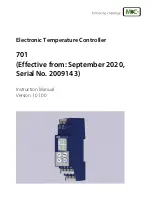
Device functions
Version 2
RES-5012
Page 49
8.16
Data memory for error messages and AUTOCAL
To simplify error diagnoses during operation, the RES-5012 controller has a data memory for error messages
(
section 8.19 "Error messages" on page 50) and executed AUTOCAL functions (
zero calibration AUTOCAL (AC)" on page 25).
The 400 most recent messages are stored. They can be read out and displayed in the ROPEX visualization soft-
ware (
section 8.12 "USB interface for visualization software ROPEXvisual
" on page 48) or via the integrated
web server.
The RES-5012 also features a built-in clock (
section 8.17 "Built-in clock (date and time)" on page 49). All mes-
sages are saved in the data memory together with their date and time of occurrence (timestamp).
The stored messages can be exported as a csv-file. If needed, ROPEX can evaluate the exported file
and create an error diagnosis.
8.17
Built-in clock (date and time)
The RES-5012 has a built-in clock. All messages are saved in the data memory (
for error messages and AUTOCAL" on page 49) together with their date and time of occurrence (timestamp). Error
messages can thus be interpreted more accurately whenever a problem needs to be analyzed.
The built-in clock can be set and read out in the ROPEX visualization software (
section 8.12 "USB interface for
visualization software ROPEXvisual
" on page 48) or using the acyclic services of the EtherCAT
®
interface. The
date and time can be read out but not set via the integrated server.
A maintenance-free capacitor is used to operate the clock. There is no battery that has to be replaced every now
and then.
The controller must remain switched on for at least three hours to make sure the clock’s capacitor is fully charged.
When the controller is switched off, the fully charged capacitor can keep the clock running for approximately 2…4
weeks. If the controller is switched off for longer, the date and time will have to be set again. You can do this in
the ROPEX visualization software (
section 8.12 "USB interface for visualization software ROPEXvisual
page 48) or using the acyclic services of the EtherCAT
®
interface.
The capacitor is not charged when it leaves the factory. When the controller is started up, you must set the clock
if you want error messages to be saved in the data memory (
section 8.16 "Data memory for error messages
and AUTOCAL" on page 49) together with their date and time of occurrence.
The controller can also be operated without the clock. In this case, the dates and times that are saved in the data
memory will be invalid (
section 8.16 "Data memory for error messages and AUTOCAL" on page 49) . However,
this has no effect on the temperature control functions.
8.18
System monitoring / alarm output
To increase operational safety and avoid faulty heatsealing, this controller incorporates special hardware and soft-
ware features to facilitate selective error detection and diagnosis. Both the external wiring and the internal system
are monitored.
These features significantly assist the operator in identifying the cause of abnormal situations.
A system fault is reported or differentiated by means of the following indications.
A.)
Red "ALARM" LED on the controller with three states:
1.
Blinking fast (4 Hz):
The AUTOCAL function should be executed (error codes 104…106, 211, 302, 303).
2.
Blinking slowly (1 Hz):
The system configuration is incorrect and the zero calibration (AUTOCAL function) was unsuccessful
(
section 7.2 "Device configuration" on page 16). This corresponds to error codes 111…114).
!
















































